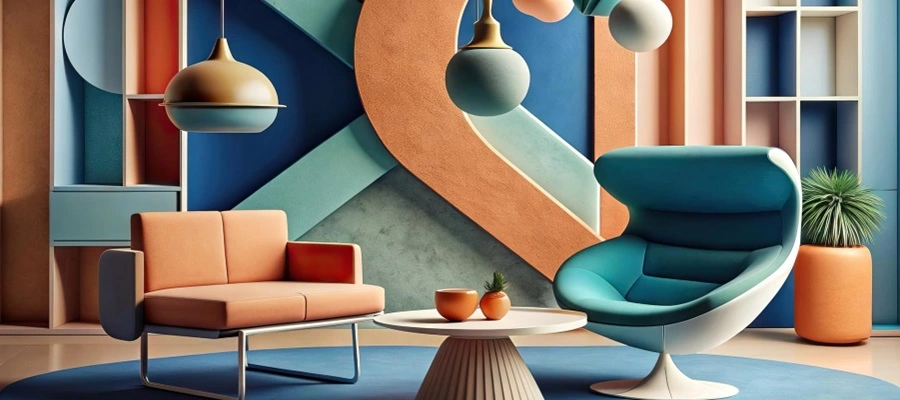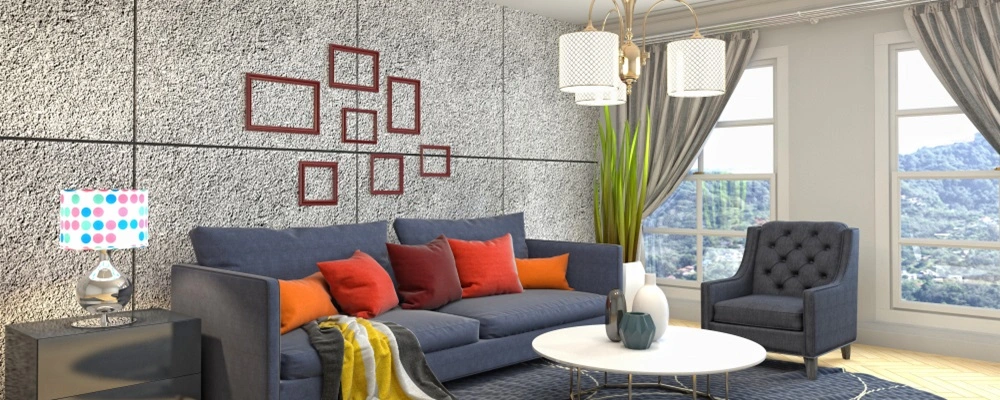Building and designing a dream home is a very personal thing, even though you might be surprised to know how much your interiors affect your moods and general well-being. Hence, you should carefully consider how you design your living spaces because it can affect your daily mood, especially because you spend so much time at home relaxing, working, and having fun. But, when you ever think about interior design, the terms creativity and style might come to your mind first. However, you would be surprised to know that science also plays a role in interior design.
Expert interior designers typically adhere to guidelines based on particular elements and principles of interior design. And by maintaining the balance of interior design elements, you can achieve a visually pleasing interior. When these components come together harmoniously, a room’s functionality and appearance will increase.
Hence, in this blog, Brick & Bolt presents the 7 most important elements of interior design for in-depth knowledge of home designing so that you can design your home like a pro!
7 Elements of Interior Design
You should always consider the following elements when designing your home interior.
1. Space
In terms of interior design, a functional space is the basic element of interior design. A functional space serves as the foundation for any interior design. As a result, you must be fully aware of the available space and the intended use of each unique space. A functional space would have two types of spaces: a positive space and a negative space. A positive space would be occupied by furniture or fixtures, such as a dining set, sofa, or other furniture, and a negative space would be one that is left empty, such as a hallway or the space between a dining set and a sofa. Because each person will need a different space for different purposes, both spaces are determined by the needs of the user. However, you must maintain and balance both areas if you don’t want them to be too crowded or empty.
In addition, interior design allows you to work in three dimensions, which means length, width, and height. So, depending on your functional and design goals, you can either fill or leave this three-dimensional space empty.
2. Colour
Colours are the key elements of modern interior design. It would be the most important thing to notice after the space’s functionality, as the aesthetic relationship between a living and non-living object is represented by colour. Colour selection can also reflect a person’s psychological attachment to the space’s usefulness.
Before choosing a colour scheme for your room, consider how you will use the space and your activities in that room. Second, keep in mind that light can change our perception of colour, so think about how your chosen colour will appear during the day and at night in both artificial and natural lighting. Finally, take the space’s dimensions into account. You can use lighter or brighter colours in smaller spaces to create an illusion of a large space. Darker shades can provide a larger area and a strong sense of dimension.
Three characteristics set each colour apart: Shade, Value, and Intensity. To execute various colour combinations or pairing adjustments, you need to understand these three factors thoroughly. For instance, light earth tones, such as beige, light brown, light warm grey, etc., would be a great option for a bedroom because they are a harmonious blend of neutral bases that reflect stability and are excellent for transforming any space into a peaceful haven with a cosy atmosphere.
3. Line
Lines that are dynamic, vertical, and horizontal aid in directing the eye and shaping a space. Harmony, unity, and contrast can be formed through the use of lines created by the structural design and furniture in the space.
- Verticle Lines:
Features like windows and doorways create vertical lines that give off a sense of strength and freedom. Functionally speaking, highlighting vertical lines creates the impression that a space is taller. You need to be careful while using vertical lines to avoid feeling uncomfortable. They are frequently appropriate for use in offices, dining rooms, and foyers.
- Horizontal Lines:
Tables and other surfaces produce horizontal lines that indicate efficiency, formality, and stability. Highlighting horizontal lines helps you elongate and widen a space while drawing attention to a central feature. However, exercise caution—overemphasising horizontal lines can give the room a lifeless, uninspired appearance.
- Dynamic Lines:
Curved, zigzag, and diagonal lines are referred to as dynamic lines. Stairs are one example of a structure with these lines providing movement and energy. Dynamic lines are visually stimulating and hold our attention for longer. On the other hand, an excessive number of dynamic lines in a space can become overwhelming and cover up vertical or horizontal lines.
You should combine various lines to create balance. Normally, you can accomplish it by choosing a single, prominent feature line that best suits your needs and the mood you want to create in the room.
4. Form

Form refers to the room’s shape and the shapes of any items in it. It’s a unique design element of interior design. Put differently, it refers to the three-dimensional physical form of any object. Forms are typically classified as natural or geometric. Geometric forms are characterised by sharp edges and hard lines that often reflect a man-made appearance, whereas natural forms are more organic and appear to have been created by nature. You can maintain harmony and balance by combining forms of similar shapes, but confusion can arise if you use them with too many different shapes.
5. Light
Light is one of the key elements of interior design. Any space needs light, whether it comes from natural sources or artificial ones. The other components could not shine to their greatest extent without it. Beyond just serving a practical purpose, light also defines colour, texture, and mood in a space. There are three types of light: accent lighting, which highlights objects; task lighting, which serves a defined purpose; and mood lighting, which creates an ambience. When thinking about lighting, it is crucial to think about the activities that will take place in the space. Here, the quantity and quality should both be evaluated.
For instance, bright lighting is necessary for an office so that employees can see well and be attentive. Conversely, a more subtle approach can be taken when lighting is applied in the living room. You can make a space much more versatile by applying a dimmer. It is always important to consider natural lighting, which can be controlled by strategically placing windows, doors and even mirrors.
6. Texture
The physical surface of an object or finish is referred to as its texture. There are two types of texture: actual texture and visual texture. Texture noticed by the eye is referred to as visual texture. Stated differently, this is the sense of texture that arises from merely looking at an object. Usually, this effect takes the shape of a pattern. Real or tactile textures have three-dimensional qualities and can be seen or felt.
Though texture is a frequently overlooked feature, it can really give the space a special touch. Similar to combining patterns and colours, you can combine textures to create a soft sense of depth in a room. Consider smooth, coarse, and glossy; texture can add interest and detail to anything, from fabric to accessories to furniture, to make it visually appealing. In short, it provides a roomy feeling.
7. Pattern
Similar to texture, you can use a pattern to enhance the appeal of a space by combining it with colour. The use of repeating designs creates patterns, which are present in fabrics, wallpaper, rugs, and soft furnishings. Many types of patterns are available, including animal prints, geometric, pictorial, organic, and striped patterns. The ideal way to apply a pattern in a room is to start by considering the room’s dimensions and design. You must be careful while using patterns in small rooms to prevent the area from feeling cluttered.
Nonetheless, patterns that produce horizontal or vertical lines can be employed to enhance the impression of space. Although complicated designs with contrasting colours and lines may brighten a space, you can use them on the feature walls. Large patterns can thrive in a large area; they turn the space into a clear focal point. Hence, to maintain the room’s essence, you must figure out which style category of the pattern belongs to your space.
Conclusion
In summary, interior design is a fascinating art form that embraces unusual elements and rejects convention. It enables you to create a living space that is entirely your own by carefully combining different interior design elements such as space, colours, form, patterns, lines, lights, and textures. Your space will appear more functional and have a more pleasing appearance when these elements work well together. So, whenever you think about your home’s interior design, consider these elements and principles of interior design, which will assist you in giving your personal touch along with the comfort and aesthetic appeal to your home.

